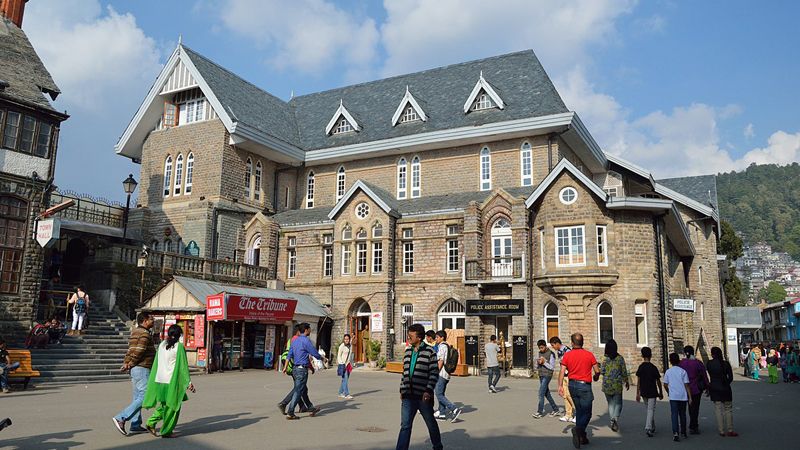
Image: https://www.shimlahp.com/
As mentioned in the Book namely “Simla Past and Present” by Mr. Long Whom and “Shimla Guide of 1870” by Mr. W.H. Garey, Shimla derives its name from “Shyeamalay” the house built of blue slate erected by a Fakir on Jakkhoo, the first nucleus of the settlement.
Another account says that Shimla means blue female or goddess Kali.
In the past, there was a temple dedicated to this goddess near Rothney castle on the Jakhu hillside.
Later during British rule, the image of the goddess was established at present site Kalibari.
The town of Shimla is built over several hills and connecting ridges.
“It is impossible that Shimla and its sublimity can ever be effaced from our minds”, wrote Sir William Loyd.
The important hills are:
- Jakhu Hill (8050 feet)
- Prospect Hill (7140 feet)
- Elysium Hill (7400 feet)
- Summer Hill (6900 feet)
- Observatory Hill (7053 feet)
The first mention of Shimla came from the diary of the Scottish officers (Brothers) Lt. Patrik and Alexander Gerrard. They mention that the area formed a part of the Keonthal state.
The British connection with the area developed only after a battle between Sikh and Gurkha and later between British and Gurkha in 1814-15. British forces came under Sir David Ochterlony and the majority of hill chiefs joined the British forces against Gurkhas. Gurkhas were defeated and forced to sign the Treaty of Sanguali.
In 1819 A.D., then an assistant political agent of hill states, Lt. Ross, set up the first British residence, a cottage of wood. His successor Charles Patt Kennedy built Pucca house in 1822 which is called Kennedy house.
The credit to introduce potato cultivation goes to Major Kennedy.
Read also: Brief Geography of District Shimla
Governor-General of India Lord Amherst became the first governor-general when he paid a visit in 1827 and he stayed in Kennedy’s house, where he said these famous lines “The Emperor of China and I govern half of the human race and yet we find time for breakfast“.
Lord William Bentinck visited Shimla in 1832 and he built a hilltop residence known as “Bentinck’s Castle”.
Governor-General Lord Auckland visited Shimla in 1838. He stayed in Auckland House.
During the annexation of Punjab, Dalhousie spent three consecutive summers from 1849-51 at Shimla. He visited in the remote of “Chinni‘ (Kinnaur) and the outcome of this was the construction of “Hindustan and Tibet Road”.
The first lap of the road was constructed in 1850-51 and this road up to Shimla came to be used for wheeled traffic by 1860.
A 560 feet long tunnel was constructed beyond Sanjauli Bazaar during 1851–52.
Sir Charles Napier was in command in the Indian army during Dalhousie’s time was unwilling to keep soldiers in the comfort of Shimla. He spent the summer of 1849 at Shimla “Barnes Court”.
During Dalhousie’s rule, Edwards was commissioner and Superintendent of Hill states (1847-1852) of Shimla. He viewed Begar System against human rights and abolished it, but later under the pressure of the European community, it was restarted during his successor William Hay.
Lord Canning paid a brief visit to Shimla in 1860. He was succeeded by Lord Elgin who was the first viceroy to start staying in Peterhoff. He died soon in 1863 and John Lawrence was appointed as Viceroy in 1863 during his time in 1864, Shimla became the summer capital of India of the British Raj.
Lord and Lady Lytton first came to Shimla in 1876, they inhabited the Peterhoff as an official government residence but he was not happy with his residence, in 1877, he selected a site on the summit of observatory hill for a new residence.
In 1883 a retired British officer A. O. Hume mooted the idea of forming Indian National congress at his residence “Rothney Castle”. He returned to England in 1892 but came back two years later to attend the congress session.
Lord Curzon (1899-1905) took interest in speedy completion of Kalka – Shimla railway under the supervision of a chief engineer. “Mr. HS Harrington”. The total length of the line is about 60 miles or 96 km, which involves the construction of 103 tunnels. The longest tunnel is “Barog Tunnel“. The railway line was opened for traffic on 31st March 1889 and the passenger train was flagged on 9th November 1903.
During Lord Curzon’s time in 1905, a tunnel was constructed under the ridge running from near the “Blessington Tennis court” an opening on to the Lower Bazaar.
During Viceroy Lord Minto delegation of Muslims met him at Shimla where formal recognition for Separate electorate to Muslim was given in 1906, which later on culminated in the form of Minto – Morley reform in 1909.
Other Info:
- ‘Shimla Past and Present’ book was written by E.J. Buck’s.
- In 1871 A.D., Shimla was given the status of a first-class Municipality under the Act of 1867. Shimla’s first secretary to Municipal Committee was Harace Bioleau Good.
- Alliance Bank of Shimla was set in 1874 A.D. with a capital of Rs. 50,000.
- On 1st June 1939, ‘Himalaya Riyasti Praja Mandal’ was launched at Shimla with ‘Pandit Padam Dev’ as President.
- Shimla was headquartering the exiled Burma government from July 1942 to 1945.
respected sir
you should mention about the journey of shimla municipal corporation.
Kindly complete all district at earliest.